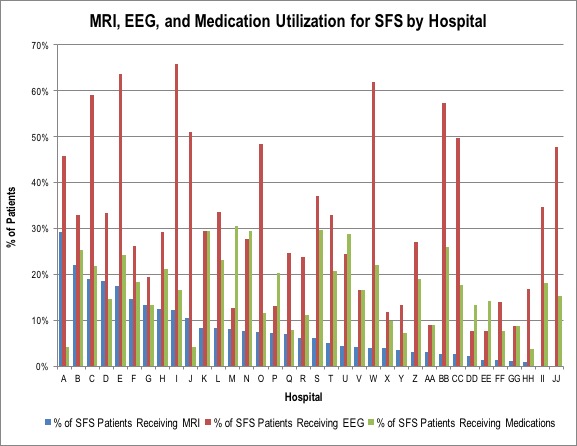NM-294
Variability in Resource Utilization in the Evaluation and Management of Children with Simple Febrile Seizures
1Saksa D, 2Huang Y, 2Sun L, 3Berry J, 3Ferrari L, 4Rodean J, 4Hall M, 3Leahy I
1UCLA, Santa Monica, CA, United states; 2Columbia University College of Physicians and Surgeons, New York, NY, USA; 3Boston Children's Hospital, Boston, MA, USA; 4Children’s Hospital Association, Lenexa, KS, USA
• Introduction: Simple febrile seizures (SFS) affect 4% of children under 5 years of age. Guidelines from the AAP and others do not recommend magnetic resonance imaging (MRI) scans, electroencephalogram (EEG) studies, or anticonvulsant treatment for children presenting with SFS. Nevertheless, there is limited data related to compliance with these recommendations for children with SFS. Our study aims to characterize resource utilization and its variability in hospitalized SFS patients in tertiary pediatric hospitals.
• Methods: This is a study using the Pediatric Health Information System (PHIS) database with data from inpatient stays between 2010 and 2015 for children from 6 months to 5 years of age who had a primary diagnosis of SFS. Children who received MRI of the brain, EEG, or were treated with anticonvulsants were compared to children who did not undergo any testing or treatment to assess patient-level differences. The primary outcome variable was hospital-level resource utilization.
• Results: Of 3640 children admitted for SFS, 32.3% had EEG evaluation, 7.5% had MRI’s, and 17.7% were treated with anticonvulsants. Overall, utilization of one of the three resources was associated with an increased use of the others, but not necessarily within a given hospital. The inter-hospital variation in utilization of MRI, EEG and anticonvulsants was not associated with a hospital’s annual inpatient volume, annual number of seizure patients or average patient’s medical acuity. As shown in the graph below, there was widespread variation in the rates at which the hospital utilized these modalities in the evaluation and treatment of SFS.
• Discussion: The study assessed the compliance with clinical practice guidelines for one condition, SFS, and sought to understand the drivers of practice style variation across 36 tertiary pediatrics hospitals. The use of anticonvulsants and neurodiagnostic testing in hospitalized SFS patients was found to be common, and the utilization of these resources varied amongst the hospitals studied with few clearly identifiable hospital or patient level characteristics contributing to the variability.
• Conclusion: The study reports significant variations in compliance with the AAP recommendations that SFS patients have no need for neuroimaging, EEG, or medications. Thus, these results suggest more work is needed to improve dissemination of and compliance with practice guidelines to ensure optimal resource utilization.
• References:
1) Consensus statement. Febrile seizures: long-term management of children with fever-associated seizures. Pediatrics, 1980. 66(6): p. 1009-12.
2) Nelson, K.B. and J.H. Ellenberg, Predictors of epilepsy in children who have experienced febrile seizures. N Engl J Med, 1976. 295(19): p. 1029-33.
3) Subcommittee on Febrile, S. and P. American Academy of, Neurodiagnostic evaluation of the child with a simple febrile seizure. Pediatrics, 2011. 127(2): p. 389-94.
Top












